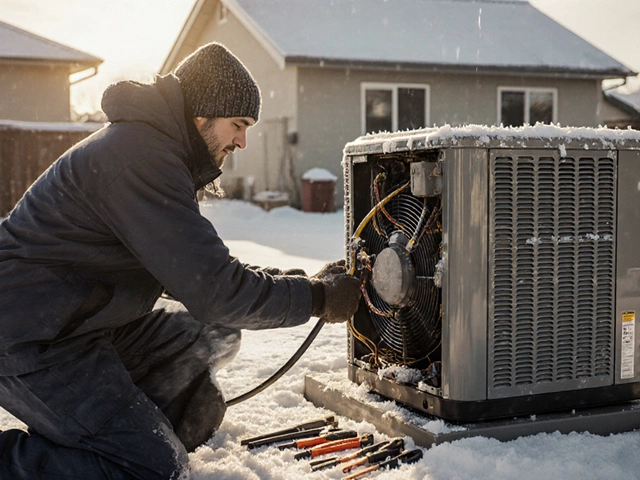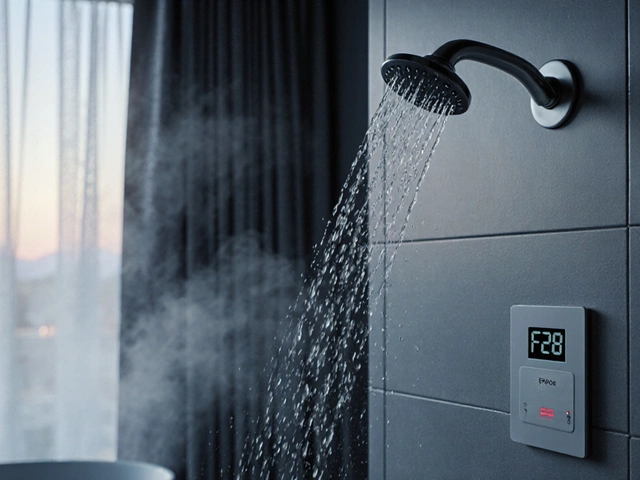It’s amazing how much life changes with a proper extractor fan. Hit the shower or fry up mushrooms, and poof—no fogged mirrors, no lingering smells. But what if your bathroom turns into a tropical rainforest after showering, or your kitchen still smells of last week’s fish? It’s tempting to grab a fan, scan some YouTube tutorials, and mount it yourself. But can you really install an extractor fan without calling an expert? Loads of folks ask this question when they notice their home needs better air quality. Here’s what you need to know before picking up that screwdriver or knocking a hole in your wall.
What You Need to Know Before Getting Started
First things first—what’s the worst that can happen? Well, extractor fans are not just fans; they’re wired into your electrics and poke a hole through walls or ceilings. In the UK, for example, the law says you can do this work yourself as long as it’s minor, but any electrical jobs in bathrooms or kitchens are officially “notifiable” work. That means you should alert building control, or risk not being able to sell your house with dodgy, un-inspected work down the line. In the US, codes can be even stricter, especially in condos or homes with tight fire and moisture barriers.
Fans are rated by their “extraction rate.” For a bathroom, you need at least 15 litres per second; kitchens need around 30-60 depending how steamy or smoky they tend to get. Every fan runs at a decibel level, too. Cheap models can sound like a plane taking off, while pricier ones purr along quietly at 25-35 dB. If you can't sleep through noise, spring for a silent fan—seriously, it’s worth every penny. Then, check if your model suits the space (wall, ceiling, window) and if it covers the right zone, especially in bathrooms, where water and electricity mix dangerously. Some models come with timers, humidity sensors, motion sensors, or even Wifi smart controls, but each extra adds wiring complexity.
Speaking of wiring, that’s often where DIYers hit a wall. UK wiring colors switched in 2004, so you may find blue, brown, black, red—sometimes all together. US homes use black (live), white (neutral), and green (earth/ground). Mess up, and boom—at best, you trip the circuit. At worst, you could trigger a dangerous “neutral fault” or fire. Handy tip: if you detect even a whiff of uncertainty, call in a professional, or at least get your final installation checked before sealing up any holes. It's worth noting that according to a 2024 UK Home Safety Study, electrical faults caused nearly 5,000 house fires that year—often traced back to DIY work in kitchens and bathrooms.
Ventilation makes or breaks the install. If your house is old and draughty, there’s less to worry about. For modern sealed homes, where the air feels as though it never moves except with fans or open windows, you risk creating a negative pressure zone. If your fan pulls more air out than leaks in, doors slam shut, cold rushes in, or, worst, lethal carbon monoxide from boilers and fires gets sucked back into your living space. Always check that there’s an adequate gap under the door, and never vent the fan into the loft or an unvented attic—mould and damp love warm, trapped air.
Legal stuff: If your extractor fan job involves new wires, drilling through brick, or making a new opening that changes your external wall or roof, local regulations might demand a permit. Mess up, and you could face fines or have trouble selling your home. In 2023, according to a survey by the Royal Institution of Chartered Surveyors, 14% of UK homebuyers faced delays because of un-permitted home improvements.
Tools, Materials, and Skills—What’s Required?
To pull off a safe and proper extractor fan install, you’ll need more than a screwdriver and a dream. Gather these essentials:
- Extractor fan (with installation kit, most come with a template and mounting kit)
- Drill (with a suitable masonry or hole saw bit – 100mm/4-inch is common, but check your fan’s spec)
- Screwdrivers (Phillips and flat-head)
- Wire strippers and electrical tester
- Spirit level and pencil (for marking cut lines)
- Dust mask, safety glasses, and gloves (cutting brick or plaster is messy business)
- Caulk/sealant (for making things airtight and weatherproof)
- Ducting, vent covers, insulation sleeves (especially for loft or long external runs)
Painters and decorators rarely mention this, but cutting a hole in your ceiling or wall is a mini demolition job. Expect fallen plaster, dust storms, and a lot of head bumping if you’re crawling round the loft. If your walls are solid brick, a core drill is needed—rent one if you don’t already own. For timber frame, things can get complicated quickly. You’ll need to check for hidden pipes, wires, or structural wood, and may need a borescope (a type of camera on a stick) to be sure.
Here’s a quick glance at the average time investment, based on 2024 survey data from DIY UK Magazine:
| Fan Location | Time for Experienced DIYer | Time for Pro |
|---|---|---|
| Bathroom Ceiling | 4–6 hours | 2–3 hours |
| Kitchen Wall | 5–7 hours | 3–4 hours |
| Upgrading Existing Fan | 2–3 hours | 1–2 hours |
| First-Time Install (new vent) | 6–10 hours | 4–6 hours |
It’s not backbreaking work, but you need patience—and good nerves. If you hate crawling in lofts, dealing with insulation, or working with wires, this is going to feel like a slog. But if you thrive on a challenge, there’s nothing more satisfying than flicking that switch and feeling the stale air pull away.

The Step-by-Step of Installing an Extractor Fan
Ready to crack on? Here’s how the full install usually plays out. The details might change by model or country, but the basics hold true pretty much everywhere.
- Choose the Spot. For bathrooms, pick an area as close as possible to the source of steam or odours, but at least 60cm away from any showerhead. For kitchens, place the fan high up on an exterior wall, over where the steam mostly gathers.
- Mark and Cut the Hole. Use the template and your level. Drill a pilot hole right through the wall or ceiling so your big core drill bit knows where to start from the outside. For walls, a 100–125mm core drill bit goes through brick like butter (almost). For ceilings, be careful with wires or pipes.
- Fit the Ductwork. Run it from the fan body to an external vent or grille. Minimize bends to avoid losing airflow, and use insulated ducting in lofts to stop condensation drips. Tape and seal all connections—but never squash the duct; airflow drops fast.
- Make It Weatherproof. On the outside, mount a grilled vent cover or louvre, sealed around the edges with exterior-grade caulk. This keeps rain, bugs, and mice out.
- Wiring Stage. Shut off power at the breaker. Pull out your wiring diagram (from the fan box or online), check your live/neutral/earth wires, and make your connections with screw terminals or push-fit blocks. If your fan has extras (like timers), it may need a permanent live and a switched live. Use an electrical tester to check power before turning on at the breaker again.
- Mount the Fan. Screw in place, checking it isn’t pinching wires or rattling. Attach the fascia or cover, and double-check everything is solid.
- Check for Drafts & Test. With the power on, test the fan works and draw a piece of tissue across the vent—it should suck it gently to show air is moving. Listen for rattles, hums, or weird noises. Run your towel under a tap and hang it nearby; it should be bone-dry in a couple of hours with the fan running.
If you’re replacing an old fan, the job is usually much quicker. Match like-for-like sizes, and the cut-outs and wiring might already be there. When working with unfamiliar wiring or ducting, always double check everything before you patch up holes or touch up the paint. A moisture meter is handy for checking if the fan keeps mould at bay—a spike means you may need a bigger fan.
When to Call a Professional?
Sure, doing things yourself saves you cash. In 2025, paying a pro in the UK for a standard install typically runs between £150 and £350, depending on complexity and location. In the US, pricing swings wild based on state, but the national average for bathroom fans hovers between $280 and $600—and that covers wiring, ducts, and an exterior vent. But money isn’t the only thing at stake. Consider calling in a professional if:
- Your bathroom or kitchen has no easy access to an exterior wall (think flats, apartments, or middle rooms)
- You aren’t confident working with household electrics, especially in “wet zones” (where code gets strict)
- The wall is thick stone, concrete, or contains tricky insulation or fire-boarding
- The location involves roof access, dangerous ladder work, or difficult duct runs
- You want integrated lights, heaters, humidistats, or smart control extras
- You’re not up for conversations with building control, or navigating paperwork for permits
And the big one—if your home insurance specifically rules out cover for non-professionally-installed electrical gear. That’s more common than you might think. Check the small print of your policy before pulling out tools.
Still keen? Loads of people have success with their first extractor fan install, and reviews online are full of “I did it myself” stories. Confidence is important, but realism matters most. If in doubt, spend £40 on a pro for a quick site check—sometimes, just having an expert talk through your plan will save you hours and headaches. If you choose DIY, document every stage: take photos of wiring, measure twice, and keep your instructions handy. You might breeze through, or hit a snag, but either way, no two homes are ever the same when it comes to airflow and electrics.
You get one shot at a really tight, safe, and quiet fan install. If you manage it, brag to your mates—you’re now king of fresh air and zero condensation. If not, don’t beat yourself up. Even the pros get stumped sometimes.





